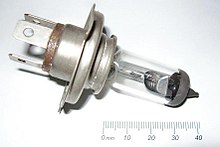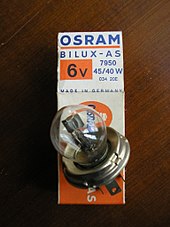dimmed headlights


The dipped beam is part of the vehicle lighting that is mandatory for vehicles . In contrast to parking lights and daytime running lights , it is not only used for your own visibility, but also to illuminate the road. Compared to the high beam , its brightness and geometry must be such that it does not dazzle oncoming traffic and other road users.
Layout and function
The low beam (formerly also driving light ) is used to illuminate the road in front of the vehicle and to be seen. For this purpose, the headlights of motor vehicles also contain a parking light , which always lights up and ensures that the vehicle is still recognized as such by oncoming traffic if the dipped beam fails.
In contrast to the high beam , which is illuminated as far as possible, the illuminated area ends in the low beam more in front of the vehicle so as not to dazzle other road users. According to regulations, the area illuminated by the motor vehicle must end 100 times the height of the headlights in front of the vehicle - the light cone must have a one percent gradient. With a mounting height of 65 cm, the light extends 65 m. A headlight tester is generally used today to adjust the low beam .
The low beam is often generated in a common headlight for low and high beam. Two-filament incandescent lamps are used for this purpose, the dipped filament of which is partially shielded by a sheet metal cover. When installed, the sheet metal cover lies under the coil, so that the light shining upwards is directed downwards onto the roadway as a fan of light via the headlight reflector.
The dipped beam in motor vehicles today generally illuminates the lane asymmetrically - in countries with right-hand traffic , the right-hand side is illuminated more intensely, and the left- hand side in left-hand traffic . As a result, oncoming vehicles are less dazzled, but at the same time the right edge of the road is clearly visible to the driver so that pedestrians, cyclists or even game on the edge of the road can be seen earlier. This idea of dazzling oncoming vehicles less fails when cycle paths are cleared for left-hand use. In Europe, the asymmetrical dimming for cars became widespread in the late 1950s. The MZ ES 125 was the world's first motorcycle to be equipped with it in 1962.
The asymmetry can be created by additional (oblique) patterns in the lens of the headlight and / or by a corresponding shape of the reflector (in modern headlights with free-form reflectors ). With two-filament incandescent lamps of old technology (without halogen), the sheet metal cover inside the lamp is also specially shaped. The asymmetrical low beam was introduced in Germany in 1957.
In the case of headlights with a lens, this area must be covered with a suitable film so that vehicles with headlights designed for right-hand traffic do not dazzle oncoming traffic when driving in countries with left-hand traffic (and vice versa). In some vehicles, an adjustment can also be made on the lamp insert using an adjustment device.
Street cleaning vehicles and trams often do not have asymmetrical dipped beam, as they are often traveling against the usual direction of traffic and an asymmetrical dipped beam would then dazzle oncoming traffic.
Legal definition in road traffic in Germany and the EU
The glare is deemed to have been eliminated if the illuminance at a distance of 25 m in front of each individual headlight on a plane perpendicular to the lane at the height of the center of the headlight and above does not exceed 1 lx . If the highest point of the illuminated surface of the headlights (paragraph 3, sentence 2) is more than 1200 mm above the roadway, the illuminance must not exceed 1 lx under the same conditions above a height of 1000 mm. In the case of headlights whose mounting height exceeds 1400 mm, the cut-off line 15 m in front of the headlight may only be half as high as the center of the headlight. In the case of headlights for asymmetrical low beam, the 1 lux limit may rise from the point corresponding to the center of the headlight at an angle of 15 degrees to the right, unless otherwise stipulated in international agreements or legal acts pursuant to Section 21a. The headlights must illuminate the roadway in such a way that the illuminance at a distance of 25 m in front of the headlights perpendicular to the incident light at a height of 150 mm above the roadway reaches at least the values specified in paragraph 5. Headlights used in pairs for high and low beam must be set up in such a way that they can only be dimmed simultaneously and evenly.
Since the inclination of the vehicles changes with the load, a headlight range control must be available. This can be done manually in the vehicle. Automatic headlight range control is mandatory for particularly bright headlights, especially those with xenon light .
literature
- Rudolf Hüppen, Dieter Korp: Car electrics all types. Motorbuchverlag, Stuttgart 1968, ISBN 3-87943-059-4
- Norbert Adolph: Car electronics / basics and building proposals. 1st edition, Verlagsgesellschaft Schulfernsehen, Cologne 1979 ISBN 3-8025-1128-X
- Jürgen Kasedorf, Richard Koch: Service primer for vehicle electrics. 15th edition, Vogel Buchverlag, Würzburg 2007, ISBN 978-3-8343-3098-7

